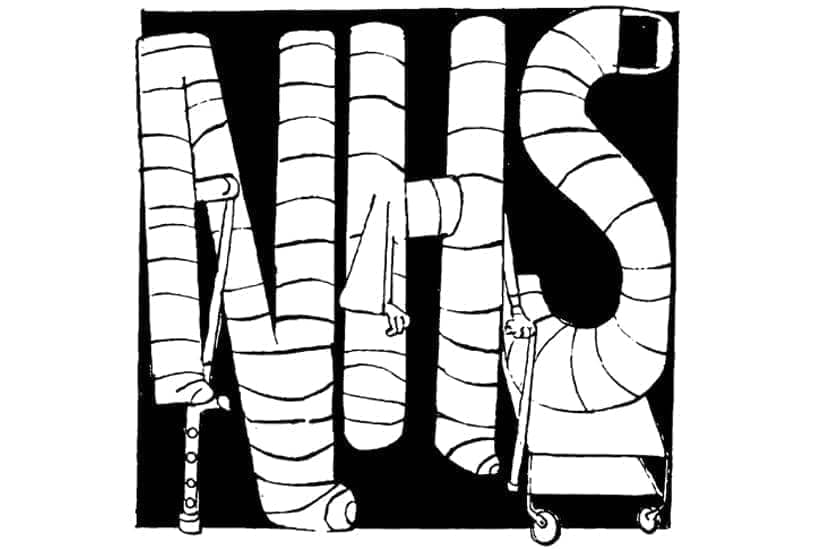Can Sajid Javid really say, as he did this afternoon in the Commons, that the government is taking action to ensure ‘that no families have to go through the same pain’ experienced by those affected by the biggest maternity scandal in the history of the NHS? The Ockenden inquiry into the maternity services at the Shrewsbury and Telford Hospital NHS Trust published its final report today, concluding that ‘repeated’ failures in care may have led to the deaths of more than 200 babies, and of nine mothers.
The individual stories of stillborn babies, infants severely and sometimes fatally harmed, and women’s pain being dismissed are deeply distressing. What is worse is the way the NHS Trust responded: as I have previously written, it was only down to two bereaved mothers that this scandal was investigated at all. The ‘repeated errors in care’ did not lead to proper reflection which was, the report said, ‘a lost opportunity to prevent further baby deaths from occurring at the trust’.
But what is even worse than the individual trust response is that this was not the NHS’s first maternity scandal. The Morecambe Bay inquiry investigated similar concerns and made similar discoveries to today’s report. Though the Shrewsbury and Telford cases stretch back to 2000, long before the deaths in Furness General, there were many years after the Morecambe Bay report when other trusts could have learned the lessons. Shrewsbury and Telford did not. In evidence submitted to Ockenden, one member of staff recalled senior staff responding to Kirkup by saying ‘We are not a Morecambe Bay’. Their reply was ‘we absolutely were a Morecambe Bay – a trust full of unhappy staff with ineffective poor leadership, looking to hide or ignore poor care and poor management’.
Will this really be the last maternity scandal? Ockenden’s national recommendations include ensuring safe staffing levels, proper training for teams and proper information to women at all stages of their pregnancies. But one aspect of the report which has got almost as much attention as the rest of its findings put together is the trust’s focus on ‘normal birth’ and a preoccupation with keeping Caesarean section rates down. One patient reported: ‘I felt that my concerns during labour were not addressed, that I was made to have a natural birth when an emergency C-section was more appropriate just so they didn’t dent their precious natural birth rate target. I felt like I was on a butcher’s slab.’ Similarly, a staff member said: ‘They were always very proud of their low caesarean rates… I personally found all the failed/attempted instrumental deliveries very difficult to deal with. I had never seen so many injuries/HIE/resuscitations from this. Nothing to be proud of.’
What hasn’t changed right up until the present day is that women themselves have largely been ignored
Sajid Javid today highlighted the ‘normal birth’ findings, saying:
It is right that both the Royal College of Obstetricians and Gynaecologists and the Royal College of Midwives have said recently that they regret their campaign for so-called formal births. It’s vital that across maternity services that we focus on safe, personalised care where the voice of the mother is heard throughout.
The history of the NHS and maternity swings from one extreme to the other. When the health service was founded in 1948, home births were the norm, but that changed over the following three decades, with successive governments supporting more hospital births. By 1970, a committee examining maternity services led by gynaecologist Sir John Peel recommended that hospitals have the capacity for 100 per cent of all births taking place within a ward. It said that this was the safest option, but it never produced evidence for that claim. Labour itself was shrouded in mystery for everyone, right up to the point a woman gave birth, when she would often find herself in a brutal and highly medicalised environment, shaved, given an enema, and strapped into stirrups, despite this not being a position particularly conducive to the movement of a baby along the birth canal. Doctors would routinely perform episiotomies regardless of whether this cut was needed to help the baby’s head emerge more easily.
One woman horrified by what she went through was Prunella Briance. On her second labour, she had a ‘ghastly experience, where I was treated with idiocy and callousness’. She was dropped while being lifted onto a bed, administered castor oil at the insistence of a doctor even though it made her violently sick, and refused a pillow. Her baby was stillborn after getting ‘stuck’. Her response to this was to investigate what she saw as the problem of highly medicalised labour in which women were given little agency. She seized upon the work of a GP in Suffolk, Dr Grantly Dick-Read, who had developed a method of ‘childbirth without fear’. The National Childbirth Association that she set up in 1956 and renamed as the National Childbirth Trust became an important guide for women to what they might expect from labour, as well as a campaigning group for a more ‘natural birth’. In the decade that followed, some midwives themselves started to organise against over-medicalisation of birth through the Association of Radical Midwives.
There were warnings at the time that the pendulum was swinging too far away from medicalised birth and towards a ‘natural birth’ that itself carried huge risks. Briance, though, continued to stick to her guns and even in 2013 was arguing in a letter to the Times that her charity was:
based on the life-work of an English GP-obstetrician who proved that 97 per cent of mothers, accurately instructed, attended and encouraged, can give birth without any interference or medication whatsoever. The remaining 3 per cent are usually ill or damaged women who require skilled medical help and are grateful for it.
It was a highly controversial assertion based on contested statistics. It also continued to rely on assumptions that pain in labour was something a woman could control. Briance’s point about women being ‘instructed’ in part referred to breathing exercises developed by Dick-Read. He wanted to liberate women from the common use of chloroform in the final stages of labour when he was working in the early 20th century. But there were more sinister influences on the natural birth movement, including from the Soviet Union, where a shortage of pain relief for women in labour made breathing techniques attractive as a means of covering up failures of state. In her forceful assault on the natural birth movement Push Back: Guilt in the Age of Natural Parenting, American obstetrician Amy Tuteur notes one big problem with these techniques: the women who were forced to accept this instead of analgesia did not find that their pain lessened. This point was largely ignored, and these methods were lauded as a success in the western world, bleeding further into a movement that claimed to prioritise women’s needs, not ignore them.
The NCT itself has since changed its framework so that it covers ‘all ways of giving birth, reflecting the various options and outcomes that individuals may experience’. This week the charity said:
We welcomed the Royal College of Midwives’ recent statement on the unintended consequences of policies which aimed to reduce unnecessary over-medicalisation and over-intervention of labour and birth. We share their sadness and deep regret that practice in some Trusts swung too far the other way – from too much intervention too soon, to too little too late.
What hasn’t changed right up until the present day is that women themselves have largely been ignored, as Ockenden pointed out. Their wishes around the method of delivery were dismissed in Shrewsbury and Telford, their cries of pain sometimes even mocked. The 1960s and 1970s saw doctors deciding that a medicalised birth was best for them, despite their cries of pain and discomfort. The emphasis on natural birth led many mothers to feel guilty that they hadn’t been able to have a ‘proper’ delivery, as though they’d not tried hard enough or hadn’t listened to ‘instructions’ of people like Briance. Could the next correction see the needs of women and their babies trump ideology and wishful thinking? The alternative is more scandal, and more days like this.






Comments